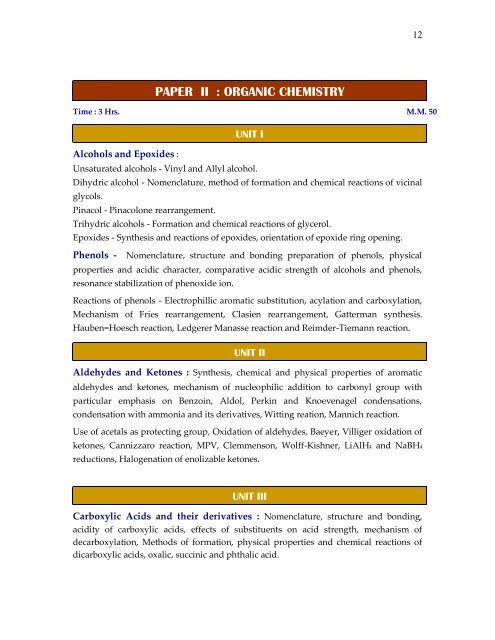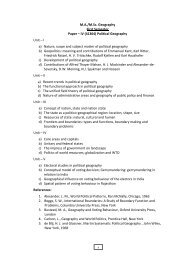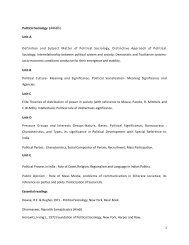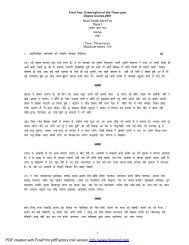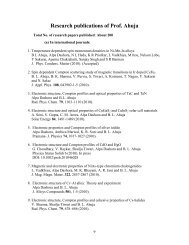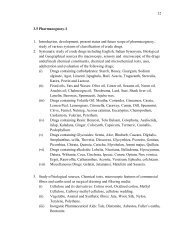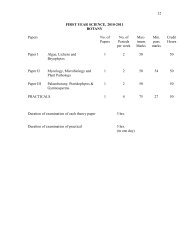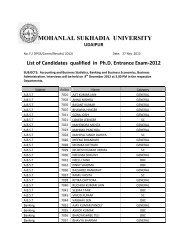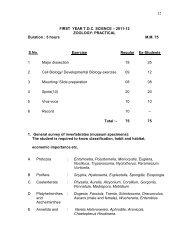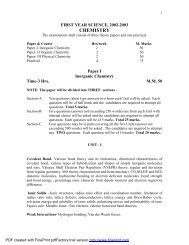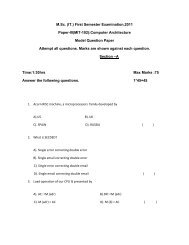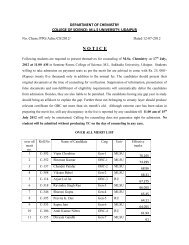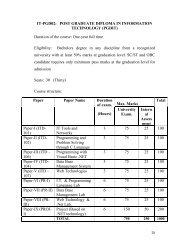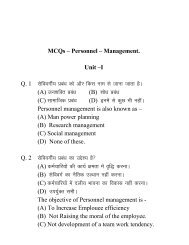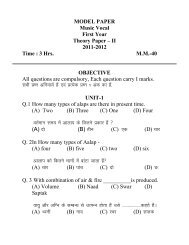PAPER II : ORGANIC CHEMISTRY
PAPER II : ORGANIC CHEMISTRY
PAPER II : ORGANIC CHEMISTRY
Create successful ePaper yourself
Turn your PDF publications into a flip-book with our unique Google optimized e-Paper software.
<strong>PAPER</strong> <strong>II</strong> : <strong>ORGANIC</strong> <strong>CHEMISTRY</strong><br />
Time : 3 Hrs. M.M. 50<br />
Alcohols and Epoxides :<br />
UNIT I<br />
Unsaturated alcohols - Vinyl and Allyl alcohol.<br />
Dihydric alcohol - Nomenclature, method of formation and chemical reactions of vicinal<br />
glycols.<br />
Pinacol - Pinacolone rearrangement.<br />
Trihydric alcohols - Formation and chemical reactions of glycerol.<br />
Epoxides - Synthesis and reactions of epoxides, orientation of epoxide ring opening.<br />
Phenols - Nomenclature, structure and bonding preparation of phenols, physical<br />
properties and acidic character, comparative acidic strength of alcohols and phenols,<br />
resonance stabilization of phenoxide ion.<br />
Reactions of phenols - Electrophillic aromatic substitution, acylation and carboxylation,<br />
Mechanism of Fries rearrangement, Clasien rearrangement, Gatterman synthesis.<br />
Hauben=Hoesch reaction, Ledgerer Manasse reaction and Reimder-Tiemann reaction.<br />
UNIT <strong>II</strong><br />
Aldehydes and Ketones : Synthesis, chemical and physical properties of aromatic<br />
aldehydes and ketones, mechanism of nucleophilic addition to carbonyl group with<br />
particular emphasis on Benzoin, Aldol, Perkin and Knoevenagel condensations,<br />
condensation with ammonia and its derivatives, Witting reation, Mannich reaction.<br />
Use of acetals as protecting group, Oxidation of aldehydes, Baeyer, Villiger oxidation of<br />
ketones, Cannizzaro reaction, MPV, Clemmenson, Wolff-Kishner, LiAlH4 and NaBH4<br />
reductions, Halogenation of enolizable ketones.<br />
UNIT <strong>II</strong>I<br />
Carboxylic Acids and their derivatives : Nomenclature, structure and bonding,<br />
acidity of carboxylic acids, effects of substituents on acid strength, mechanism of<br />
decarboxylation, Methods of formation, physical properties and chemical reactions of<br />
dicarboxylic acids, oxalic, succinic and phthalic acid.<br />
12
Substituted Acids - Methods of formation and chemical reactions of halo acids, hydroxy<br />
acids, malic, tartaric, citric and salicyclic acids.<br />
Unsaturated Acids - Acrylic and cinnamic acids.<br />
Introduction to acids derivatives - Preparation, properties and uses of acid halides,<br />
amides, anhydrides and esters. Interconversion of acid derivatives by nucleophilic acyl<br />
substitution. Mechanism of HVZ reaction, Hofmann - bromamide reaction and ester<br />
hydrolysis.<br />
UNIT IV<br />
Organic Compounds of Nitrogen : Preparation and chemical reactions of<br />
nitroarenes. Reactivity of nitro substituted arenes.<br />
Aromatic amines, classification, preparation, properties and uses of primary amino<br />
compounds aniline, acetanilide, nitroanilines.<br />
Secondary amino compounds - diphenylamine and N-methylaniline.<br />
Tertiary amino compounds - Triphenylamine and N,N-dimethylaniline.<br />
Aryl alkyl amine - Benzylamine.<br />
Basic strength of amines - similarities and differences between aliphatic and aromatic<br />
amines.<br />
Diazonium salt - formation, properties and synthetic uses of benzene diazonium salt,<br />
Diazo coupling and its mechanism.<br />
Organic Sulphur Compounds : Preparation and properties of thiols, sulphonic acid,<br />
sulphonyl chloride, saccharides, chloramine -T. dichloramine-T and sulphonamides.<br />
UNIT V<br />
Polynuclear Hydrocarbons : Nomenclature of naphthalene and anthracene<br />
derivatives, preparation and properties of napthalene, anthracene, naphthol,<br />
naphthylamine, naphthaquinone and anthraquinone.<br />
Mechanism and orientation of electrophilic substitution reaction in naphthalene and<br />
naphthalene and anthracene.<br />
Organic Compounds : Preparation, properties and synthetic uses of organo lithium<br />
and organo zinc compounds.<br />
BOOKS RECOMMENDED<br />
1. A Text Book of Organic Chemistry : K.S. Tiwari, S.N. Mehrotra and N.K. Vishnoi.<br />
2. Modern Principles of Organic Chemistry : M.K. Jain and S.C. Sharma<br />
3. A Text Book of Organic Chemistry : (Vol. I and <strong>II</strong>), O.P. Agarwal.<br />
4. A Text Book of Organic Chemistry : B.S. Bahl and Arun Bahl.<br />
5. A Text Book of Organic Chemistry : P.L. Soni.<br />
6. Organic Chemistry : (Vol. I, <strong>II</strong> and <strong>II</strong>I), S.M. Mukherji, S.P. Singh and R.P. Kapoor<br />
7. Organic Chemistry (Hindi Ed.) : Suresh Ameta, P.B. Punjabi and B.K. Sharma, Himanshu Pub.<br />
13


